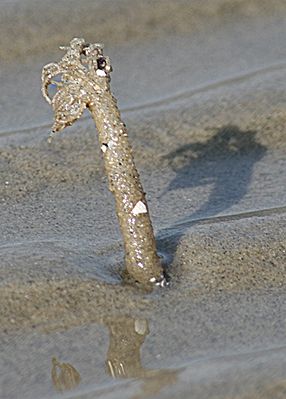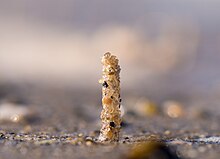Sapling tube worm
| Sapling tube worm | ||||||||||||
|---|---|---|---|---|---|---|---|---|---|---|---|---|

Tube of the sapling tube worm |
||||||||||||
| Systematics | ||||||||||||
|
||||||||||||
| Scientific name | ||||||||||||
| Lanice conchilega | ||||||||||||
| ( Pallas , 1766) |
The sapling tubeworm ( Lanice conchilega ) is a cosmopolitan marine annelid from the genus Lanice within the polychaete - family of Terebellidae . He builds tubes made of sediment particles on sandy seabeds. Its tube is up to 40 cm long and protrudes about 1 to 2 cm from the sandy seabed. At the top of the tube there is a tree-shaped filter apparatus made of solid mucus and sediment.
features
The sapling tubeworm has a long body with a cylindrical, firm thorax and a very long, pointed, soft abdomen. It becomes up to 30 cm long and then has about 300 segments , of which the thorax comprises 17 bristle-bearing segments. In the North Sea , lengths of up to 8 cm are common. At the junction of the prostomium and the peristomium there are around 100 long tentacles with which microscopic food particles are picked up and fed to the mouth. The narrow upper lip almost completely encloses the mouth. Large lobes protrude laterally and ventrally from the buccal segment. The animal has numerous eye spots. Near the head end of the segments 2 to 4 there are three pairs of roughly equal, tree-like gills with a short, thick trunk and a strongly branched crown. The characteristic long side lobes of the 3rd segment laterally cover the 2nd segment. The animal has 14 to 20 ventral shields. From the 4th segment on there are notopodia and from the 5th segment onwards there are very long hook-bearing tori , which are in two rows on segments 11 to 20. The pygidium has 4 small papillae. The notopodia are smooth and have a narrow edge. The Uncini with have one large and several small teeth.
The animal is yellowish, pink or brown, the tentacles pale, the gills, which are well supplied with blood, are red, and the ventral shields are partly reddish. Mating-mature females are reddish brown due to their eggs, the males yellowish white due to the sperm. In alcohol, the animals turn gray or pale yellow in color.
Lanice conchilega builds a living tube up to 40 cm long from a thin, cylindrical layer of mucus secretion, grains of sand and shell fragments, which usually protrudes about 1 to 2 cm above the substrate surface and here forms a flattened funnel with one or more often branched crowns that are always at right angles to the main flow direction and are provided with a sand-covered border. If the tube is sanded over or flushed, the animal can repair it within a few hours.
distribution and habitat
Lanice conchilega is cosmopolitan in all oceans, including in the northeastern Atlantic Ocean including the North Sea , in the Mediterranean , Persian Gulf and Pacific Ocean including the coasts of Australia .
The tree tube worm lives close to the coast in the mudflats and up to a depth of more than 1700 m on more or less mixed sandy, more rarely on muddy surfaces, also between Zostera and benthic large algae and on changing substrates.
Life cycle
The worms can live up to 3 years. They are separate sexes and mate in the northern hemisphere in spring and summer. The fertilization takes place in the open sea water. At the age of 5 days, the approximately 0.2 mm long larva , which live as zooplankton, develops a tube of mucus and detritus. At about 60 days of age, the 2.25 to 3 mm long larva has 12 to 14 thorax segments with bristles and 3 long and 2 short tentacles, while the mucous tube is slightly shorter. At this age, the larva sinks to the bottom and replaces its larval tube with a new living tube in which the sand particles and shells of foraminifera , as well as sea urchin spines and mussel shells, are fixed to solidifying mucus. The young worms prefer to settle in an old tube. In hard winters with lots of frost, all tree tubeworms freeze to death. Since, like most bristle worms, reproduction takes place via tiny, free-swimming larvae, the species can spread widely and repopulate frozen areas. However, since the young worms grow only slowly, repopulation is also slow.
Way of life
Lanice conchilega lives permanently in his dwelling tube, the slimy tree-like crown of which is used to filter detritus (including excrement from echinoderms and molluscs ), but also plankton ( foraminifera , ciliates , copepods , algae ) from the water . At high population densities, it evidently tends to pick up detritus from the substrate. The food particles are collected from the mouth funnel and the “tree crown” of the tube with the help of the numerous tentacles and fed to the mouth.
In the event of a malfunction, the worm retreats quickly and deeply into its tube and holds onto the side bristles. At low tide it also stays deeply withdrawn in the living tube and only stretches out its tentacles again between the branches of the tree-shaped crown of the tube with the tide.
Ecological importance
Due to its ability to build a large number of living tubes with high numbers of individuals, the tree tube worm is considered to be potentially reef-forming. The tubes of the multi-bristle influence the structure of marine biotopes and thus the composition of the species considerably.
Predators
The predators of Lanice conchilega include waders , gulls and flatfish , but also predatory snails such as the whelk ( Buccinum undatum ) and the wood turner ( Acteon tornatilis ).
literature
- JD Fish, S. Fish: A Student's Guide to the Seashore. Cambridge University Press, 2011. pp. 169-171.
- Gesa Hartmann-Schröder (1996): Annelida, Borstenwürmer, Polychaeta. Tierwelt Deutschlands 58, pp. 1–648, here p. 482.
- Stanley J. Edmonds: Fauna of Australia, Volume 4A. Polychaetes & Allies. The Southern Synthesis 4. Commonwealth of Australia, 2000. Class Polychaeta. Pp. 303-311, Family Terebellidae.
Web links
- Species profile on the homepage of the Wadden Sea Conservation Station
- MJ de Kluijver et al .: Lanice conchilega (Pallas, 1766). Macrobenthos of the North Sea - Polychaeta, Marine Species Identification Portal
- MJ de Kluijver et al .: Lanice conchilega (Pallas, 1766). Zooplankton and Micronekton of the North Sea - Polychaeta, Marine Species Identification Portal
- Olwen Ager: Lanice conchilega. MarLIN, Biodiversity & Conservation.
Individual evidence
- ^ KJ Buhr, JE Winter: Distribution and maintenance of a Lanice conchilega association in the Weser estuary (FRG), with special reference to the suspension-feeding behavior of Lanice conchilega. Proceedings of the Eleventh European Symposium of Marine Biology, University College, Galway, 5-11 October 1976. In: BF Keegan, PO Ceidigh, PJS Boaden (Ed.): Biology of Benthic Organisms, pp. 101-113. Pergamon Press, Oxford 1977.
- ↑ M. Rabaut, M. Vincx, S. Degraer (2009): Do Lanice conchilega (sandmason) aggregations classify as reefs? Quantifying habitat modifying effects. Helgol. Mar. Res. 63, pp. 37-46.
- ^ P. Feral (1989): Biosedimentological implications of the polychaete Lanice conchilega (Pallas) on the intertidal zone of two Norman sandy shores (France). B. Soc. Geol. Fr. 5, pp. 1193-1200.
- ↑ Barbara Petersen, Klaus-Michael Eco (1999): Predation of waders and gulls on Lanice conchilega tidal flats in the Wadden Sea. Marine Ecology Progress Series 178, pp. 229-240.
- ↑ J. Vanaverbeke, U. Braeckman, S. Claus, W. Courtens, N. De Hauwere, S. Degraer, K. Deneudt, A. Goffin, J. Mees, B. Merckx, P. Provoost, M. Rabaut, K. Soetaert E. Stienen and M. Vincx (2009): Analysis of long-term data from the Belgian Continental Shelf in the framework of science-based management of the coastal North Sea. Workshop Report WestBanks, Ostend, October 29th to 31st, 2008.
- ↑ Claus Nielsen (1975): Observations on Buccinum undatum L. attacking bivalves and on prey responses, with a short review on attack methods of other prosobranchs. Ophelia 13, pp. 87-108.
- ↑ MJ de Kluijver, SS Ingalsuo & RH de Bruyne: Acteon tornatilis (Linnaeus, 1758). Mollusca of the North Sea, Marine Species Identification Portal.



